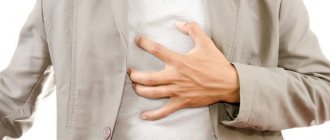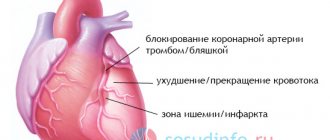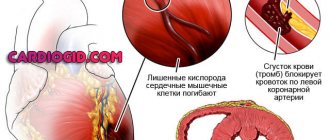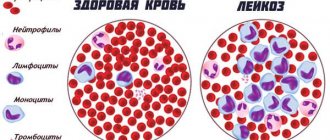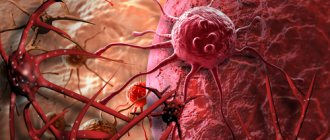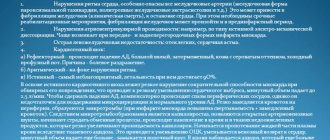Stroke in men refers to a disease that is accompanied by acute cerebrovascular accident with the sudden onset of neurological symptoms. A vascular accident can be caused by the formation of a blood clot in the lumen of a vessel or rupture of a vein or artery. In acute circulatory disorders, symptoms persist for a long time and may be irreversible, while in transient ischemic attack they are short-lived. In clinical practice, stroke often leads to death. In most cases, strokes and micro-strokes in men lead to permanent disability.
Types of stroke
According to the mechanism of development, stroke is divided into:
- Ischemic. This option is called cerebral infarction. Older patients are most susceptible to its development. These are predominantly men over 60 years of age with a history of diabetes, heart rhythm disturbances or heart defects. The cause of ischemic stroke is the formation of an atherosclerotic plaque or thrombotic masses that are unstable in the lumen of the vessel. When a thrombus or embolus breaks away from its place of attachment, it blocks the lumen of the vessel, impairing blood circulation. Insufficient oxygen supply from the blood to certain parts of the brain leads to the death of nerve cells. Cerebral infarction occurs less frequently when vital structures are compressed by a tumor.
- Hemorrhagic. The mechanism of this type of stroke is associated with hemorrhage in the brain. The disease can be subarachnoid or intracerebral. It is more often diagnosed in patients 40-60 years old. Susceptible to the development of facial pathology with the presence of atherosclerosis, hypertension or blood diseases. Hemorrhage develops when the vascular wall ruptures at the site of the aneurysm or when it thins against the background of atherosclerosis.
- A subarachnoid stroke is characterized by blood getting between the soft and arachnoid membranes of the brain, penetrating into the cavity of the spinal cord.
- Transient ischemic attack. The disease is associated with a short-term blockage of the lumen of the vessel, disrupting blood circulation in the feeding sections. The condition is accompanied by the appearance of symptoms characteristic of a typical stroke. As a rule, all signs disappear after a few minutes, therefore, the patient cannot always understand what may happen to him. This option is the most dangerous due to the fact that in the absence of therapy, the development of a stroke is possible.
Causes of microstroke
TIA develops when one of the following situations occurs:
| Cause | What causes TIA |
| Atherosclerosis of the cerebral vessel | One of the reasons: • if a piece of atherosclerotic plaque came off and clogged - not completely, but by 55-75% - a narrow part of the vessel located closer to the brain tissue, and then dissolved by the body; • if a thrombus is layered on an atherosclerotic plaque and reduces (does not block) the lumen of the vessel, after which it dissolves over time; • if the wall of the vessel in which the atherosclerotic plaque is deposited has become thicker, causing the diameter of the vessel to decrease. |
| Thrombosis of the lower extremities, including those occurring as a result of taking contraceptives, varicose veins. The risk is higher if, in addition to dilated veins, thrombophlebitis or taking contraceptives, a person suffers from arrhythmia | The blood clot breaks off and “travels” through the bloodstream, as a result of which it stops in one of the brain vessels, disrupting the nutrition of neurons, and then the blood clot dissolves |
| Smoking or taking substances that cause vasospasm | The vessels are strongly compressed, in one of the areas (usually the vessel most affected by inflammation, diabetes mellitus or other pathology), blood almost stops flowing to the brain, but then the spasm goes away |
| Surgeries on bones (especially large ones), burns, bruises of the subcutaneous tissue | Entry of a suspension containing fat molecules into the bloodstream, followed by short-term blockage of one of the cerebral vessels |
| Subclavian steal syndrome | In this case, there is a narrowing of the subclavian artery even before the vertebral artery, which supplies the brain stem, leaves it. When a person with such a disease actively works with his hands, most of the blood goes to the hands, and parts of the brain do not receive enough nutrition |
| Anemia (too low hemoglobin) | Not enough oxygen reaches the brain due to the fact that there are few molecules transporting it (hemoglobin) |
| Carbon monoxide poisoning | Hemoglobin is blocked by a carbon monoxide molecule and cannot carry oxygen |
| Increased blood viscosity: with a large number of red blood cells (polycythemia), chronic heart or bronchial diseases, constant intake of small amounts of fluid | From time to time, blood cannot “squeeze” through some small vessels |
Risk factors
Risk factors for the development of the disease include pathological conditions that most often damage blood vessels. Among them are:
- Arterial hypertension. Abnormal blood pressure is a dangerous condition. Despite the fact that the patient's condition may not change, the load on the vascular wall increases. As the pathological process progresses, it becomes thinner and less elastic. In places of greatest thinning, aneurysms may appear, which, due to sudden pressure surges, break through and cause bleeding into vital structures.
- Low level of physical activity. A sedentary lifestyle with insufficient energy expenditure during the day significantly increases the risk of developing the disease. As a result, a gradual increase in body weight may occur, as well as stagnation of blood in the venous system. This condition leads to increased blood pressure, thickening of the blood and possible blood clots.
- Increased serum cholesterol levels. Cholesterol can not only thicken the blood, but also be deposited in the walls of blood vessels. Blood vessels gradually thicken, they are less elastic and conduct blood worse. As the pathological process progresses, a plaque forms in the lumen, which in severe cases blocks the lumen of the vessel. If the lumen is unstable, it comes off. Due to increased cholesterol, hemorrhagic and ischemic variants can develop.
- Smoking. Inhaling nicotine vapor increases the risk of developing the disease by more than 12%. A bad habit not only worsens the condition of internal organs, but also the walls of blood vessels. They become more brittle. Nicotine entering the blood narrows their lumen causing an increase in blood pressure. After the patient quits smoking, the state of the cardiovascular system is restored after 2-3 years.
- Malnutrition and obesity of the patient. An increased likelihood of stroke is observed when the patient abuses foods containing large amounts of low-density lipoproteins and cholesterol. These include fast food, fried, smoked, spicy and salty foods. In addition, the disease can develop with excessive consumption of alcoholic beverages.
- Excess body weight causes increased stress on the heart, diabetes, and hypercholesterolemia. The leading indicator for assessing this risk factor is body mass index. It is calculated by dividing body weight by the patient's height squared.
- Diseases of the cardiovascular system. Heart defects, atrial fibrillation, or other rhythm disturbances disrupt the rheological properties of the blood and cause blood clots to form in the atria or ventricles. These blood clots enter the systemic circulation and blood vessels through the bloodstream.
- Stressful impact. Hormones produced during stress negatively affect the functioning of various organs and systems. First of all, they provoke an increase in blood pressure. In addition, they suppress insulin levels, increasing blood sugar, which also causes the development of diabetes. The possibility of smoking as a way to cope with stress cannot be ruled out.
- Diabetes. Elevated glucose levels damage the vascular wall, making it more fragile and vulnerable to other pathological influences. People with diabetes have a more difficult time suffering from acute circulatory disorders. Their life prognosis is often unfavorable.
These risk factors are preventable. The patient can eliminate them in a timely manner or change their lifestyle, which will prevent the disease. At the same time, conditions are identified that a person cannot influence. Among them are:
- Elderly age.
- Burdened heredity.
- Floor. Men are less likely to experience circulatory problems.
- Anamnesis of life.
First aid for microstroke
When symptoms of focal neurological dysfunction caused by a transient ischemic attack appear, first aid for a microstroke is necessary.
Be sure to call an ambulance (reporting the exact time when symptoms began) or quickly take the person to the nearest medical facility. When a person becomes ill on the street, you should find out if he has diabetes, and if he has this disease, give him a glucose tablet or a glass of a sweet drink (to urgently increase blood sugar levels).
While waiting for medical help to arrive, carefully monitor the person's condition. And to recognize a micro-stroke or stroke, paramedics recommend asking the person to smile (to check for changes in facial expressions) and repeat a simple sentence (to check for speech impairments).
You should also ask the person to raise both hands or squeeze your hand tightly (this can reveal hand weakness). If left arm weakness is detected, the person should be turned onto the right side (and vice versa) to allow gravity to direct blood to the affected hemisphere of the brain.
The rest is up to the doctors, whose task is to avoid a delay between the onset of symptoms and their diagnosis. Because it is necessary to use PLAT - recombinant tissue plasminogen activator (Alteplase, Reteplase, Tenecteplase) within the first three hours from the onset of signs of an ischemic attack. By catalyzing the conversion of plasminogen to plasmin, the main enzyme responsible for clot breakdown, PLAT promotes the breakdown of blood clots in blood vessels. But it is not used in the case of hemorrhagic microstroke and stroke (for which anticoagulants are required).
[], [], [], [], []
Main symptoms of stroke in men
Before the development of the main symptoms of the disease, the patient may encounter the appearance of precursors of pathology. These include:
- Development of severe headache. People with cephalalgia note a marked deterioration in their health, but it cannot be treated.
- Dizziness. Headache with dizziness leads to loss of coordination. A person feels the desire to lie down and remain motionless.
- Nausea not associated with eating. Problems with coordination of movements. The victim experiences difficulty performing certain manipulations, such as writing or small precise movements.
- Speech disorders. Speech becomes blurred, so those around you do not always understand the meaning of the phrases spoken.
- Feeling of blood rushing to the head. The face becomes purple and the person experiences a fever.
- Sudden change in mood. Against the background of a good mood, pronounced aggression or tearfulness is observed.
- The appearance of slight numbness. As a rule, it is one-sided.
The appearance of these signs is an indication for the patient to seek medical help urgently. At the stage of precursors, with the correct diagnosis, therapy is selected to prevent further progression of the process. The main signs of stroke in men include:
- Decreased or complete loss of muscle strength in the upper or lower extremities.
- Involuntary drooling and impaired swallowing function. When a stroke develops, the patient may experience a sore sensation when eating food or the inability to swallow it.
- The development of unbearable headaches, in which patients begin to scream and take a forced position.
- The appearance of confusion with memory loss or coma. Coma is most often associated with a community lesion.
- Uncontrollable vomiting that does not bring relief. As the pathological process is programmed, no appearance of gastric contents is noted during vomiting.
- Loss of coordination with inability to walk.
- Involuntary defecation and urination.
- Decreased hearing and vision. The process can be unilateral or bilateral, depending on the severity of the pathological process.
- Drooping of the eyelid and corner of the mouth on one or both sides.
- Bradycardia.
- Paralysis or paresis of the limbs.
- Convulsive syndrome resembling epilepsy.
How to detect a microstroke at home
The first manifestations of coronary artery disease are usually noticed at work, at home, or on the street. To verify the signs of an extensive microstroke, you can carry out a number of indicative checks before the ambulance arrives.
Attention. The first thing you need to pay attention to is the victim’s smile. When asked to smile, you may notice asymmetry in the corners of the mouth.
The person begins to speak indistinctly, lexical units and sentences are pronounced slowly and unclearly. There are problems with raising the limbs: the patient will not be able to raise his arms in parallel due to a blockage of the blood supply to the brain.
The main symptoms of a microstroke in men
All signs of microstroke in men can be divided into general and focal. General cerebral manifestations include:
- Headache with dizziness and headache, as well as flickering before the eyes.
- Loss of coordination with unsteadiness when walking, changes in gait and a feeling of weak legs.
- General muscle weakness.
- Impaired consciousness with drowsiness or increased nervous agitation.
- Increased sensitivity to external stimuli.
Focal symptoms include:
- Manifestation of muscle weakness in the left or right half of the body.
- Paresis or paralysis in the upper and lower extremities.
- Lack of speech or slurred speech.
- Numbness of the face and its asymmetry.
- Deterioration of memory with its possible loss.
- Changing your thinking.
Consequences of a microstroke suffered on the legs
We remind you that a transient ischemic attack requires hospitalization. It allows you to find out the reason why the attack occurred. If you do not seek help in time, the attack may recur. Some patients experience several attacks per day. And each of them can end fatally.
A microstroke suffered on the legs usually leads to ischemic-type ONCM, severe arrhythmia. In addition, TIA leads to decompensation of coronary heart disease.
Men
The stronger sex is more likely to experience micro-stroke. And this group has the highest number of refusals from hospitalization. This is why a transient attack is dangerous. The affected vessels are so small that they do not cause severe damage. Or the symptoms disappear altogether. This imaginary well-being usually leads to severe strokes. And the most common reason is the lack of timely medical care.
Remember about the risk group:
- Age over 60 years;
- Drinking alcohol;
- Smoking;
- Obesity;
- Diabetes;
- Arterial hypertension;
- Systemic atherosclerosis.
Microstroke in diabetes mellitus (DM)
It is known that blood vessels are additionally affected in this disease. Their walls become thinner, and atherosclerosis progresses. An additional risk factor is increased diuresis in diabetes. This creates additional conditions for blood thickening. Therefore, strokes with diabetes occur 2.5 times more often.
In an elderly patient with this disease, the risk of having a stroke after a TIA increases several times. And the main role in this is played by collateral circulation. When a blood clot closes a major vessel, blood rushes around the blockage. At the same time, diabetes turns small capillaries into hard “glass” tubes that are not able to compensate for such blood flow. Ischemia intensifies.
Women
Micro-stroke “on your feet” is experienced by 30-40% of the population in developed countries. In Russia there are no adequate statistics. However, these numbers will be higher. What follows an ischemic attack in a woman?
Firstly, any brain hypoxia leads to unusual fatigue, depression and headaches. If the patient has not experienced them before, this is a reason for examination. Secondly, after a TIA, performance and cognitive functions are significantly reduced. This affects the quality of work, especially if a woman holds a leadership position.
Consequences of an attack depending on its location
So, any attack occurs as an ischemic type of stroke. There are two types of TIA based on the location of the lesion:
- Vertebro-basilar basin;
- Carotid basin.
So, the first option occurs in 70% of cases. What symptoms accompany the event?
- Dizziness with occipital pain;
- Nystagmus;
- Diplopia (double vision);
- Nausea and vomiting;
- Loss of half the visual field (usually bilateral);
- Flashing “flies” before the eyes;
- Damage to the muscles of the face, pharynx, tongue, soft palate;
- Sudden fall without loss of consciousness;
- Short-term loss of memory and orientation.
TIA in the carotid region behaves like this:
- Loss of sensation in one or more limbs;
- There is no movement in one or more limbs;
- Speech is partially or completely lost;
- Vision disappears in one eye, paralysis of half the body develops on the other side.
Ischemic stroke
TIA lesions resolve within 10 minutes to 1 hour. If the symptoms do not go away within a day, a diagnosis of acute cerebrovascular accident is made. And this is a completely different disease. It has a high mortality rate and a long rehabilitation period.
How to treat ischemic stroke?
- Correction of blood pressure at numbers above 200/110 mmHg. You cannot reduce the pressure at lower numbers, otherwise the blood supply to the brain will stop altogether. You should also not use medications that give a quick effect (nifidipine). Preference should be given to captopril, enalapril;
- Fighting cerebral edema (mannitol);
- Diazepam is administered to relieve seizures.
When treated in a hospital, the patient is given neuroprotective therapy. These are glycine, emoxypine, cytoflavin, cerebrolysin.
The main differences between a stroke and a microstroke
The main difference between these diseases is less pronounced symptoms, which disappear on their own a few minutes after the incident. Unexpressed manifestations preserve the patient’s ability to occupy a comfortable position, since in case of acute circulatory disorders people take a forced position.
Helpful information
In addition, with a microstroke, the thrombus does not completely block the lumen of the vessel, due to which blood can flow to a small extent to the lesion without leading to extensive necrosis.
Complete obstruction is characterized by rapid growth of the infarct focus followed by pathological symptoms.
Diagnostics
Diagnosis of a stroke begins with clarifying the patient’s complaints, if he is conscious. If necessary, ask others or relatives about what happened. The conditions that could cause the disease are determined. In addition, the doctor needs to obtain information about concomitant pathologies, medical history and medication use.
Subsequently, the person is examined to assess his well-being, main symptoms, and reflexes. Based on the information received, additional research methods are selected, which include:
- Magnetic resonance or computed tomography. These studies are highly accurate and allow you to identify the pathological focus.
- Cerebral angiography. When contrast liquid is injected into the circulatory system, it is possible to identify the level of damage.
- Echocardiography.
- General clinical and biochemical blood test.
First signs
For most men, symptoms of a mini-stroke appear suddenly and disappear just as quickly. However, only about 20% can recognize an approaching micro-stroke and contact an ambulance.
The first signs of an approaching micro-stroke are the following symptoms:
- Strong headache.
- Sudden weakness.
- Lethargy.
It should be borne in mind that a micro-stroke can last a matter of seconds or minutes , so most men do not pay much attention to it.
Read more about the symptoms, as well as the difference between the mild form and the usual one, here.
Prevention
To prevent or reduce the risk of stroke, you must:
- Avoid smoking and drinking alcohol.
- Prevent stress exposure.
- Monitor your blood pressure and sugar levels regularly.
- Reduce excess body weight.
When the first signs of the disease appear, it is necessary to seek help from a doctor as soon as possible. To do this, you should call an ambulance and do not attempt self-treatment. If vital functions are impaired, resuscitation measures are required.
Treatment
If an adult male develops a transient ischemic attack, immediate action is required. The sequence of resuscitation measures is as follows:
- First of all, the patient is placed on a hard horizontal surface, after which the body position is not changed.
- To avoid cerebral edema, the man carefully tilts his head back and places a cushion under his neck.
- Afterwards, the victim is removed from clothing, thereby ensuring unimpeded access to oxygen (it is advisable to open a window in the room).
- If a man begins to vomit, his head is turned to the side so that he does not choke on his own vomit.
- If possible, the patient's blood pressure is measured and the patient is given medication previously prescribed by the doctor.
- Then you need to wait for an ambulance. Hospitalization is required.
In case of a microstroke, the patient is prescribed drug therapy, complete rest, proper rest, a therapeutic diet, weight control and blood pressure control. It is important for a man to completely eliminate physical and emotional stress, avoid stress and nervous tension. The patient needs to give up bad habits, lead a healthy lifestyle, and undergo regular medical examinations. Such preventive measures help prevent relapse and avoid ischemic attacks.
A prerequisite for the recovery period for a microstroke is drug therapy. Medications and their combinations are prescribed only by a specialist - cardiologist, neurologist, therapist. Self-medication is contraindicated and is harmful to a man’s health. With symptoms of a microstroke, positive dynamics are provided by the following pharmacological groups and their representatives:
- Anticoagulants are necessary to prevent intravascular coagulation. This group is represented by the drugs Heparin, Warfarin, Neodicoumarin, Fragmin, Fraxiparin.
- Thrombolytics (fibrinolytics) prevent the development of thrombosis, normalize the patency of blood vessels, expanding their lumen, dissolve dense blood clots, and prevent cardiac ischemia.
- Antihypertensive drugs regulate blood pressure and prevent the exacerbation of arterial hypertension. These are the beta blockers Metoprolol and Bisoprolol, the calcium antagonists Nifedipine and Amlodipine, the ACE inhibitor Enap, the ganglion blocking agent Benzohexonium, and the drugs Farmadipine.
- Antiplatelet agents slow down platelet aggregation, prevent the formation of blood clots, subsequent blockage of blood vessels, and the development of atherosclerosis. This group is represented by the drugs Aspirin-Cardio, Mezaton, Clonidine.
- Angioprotectors strengthen vascular walls, increasing their elasticity and permeability, and maintain uninterrupted blood supply to the myocardium. The group is represented by medications Tanakan, Nimopidin, Bilobil, Actovegin, Mildronate, Cytoflavin.
- Nootropic drugs are necessary to normalize cognitive functions, calm and relax a tense nervous system, provide nutrition to brain cells, stimulate thought processes, and memory. Nootropics include Vinpocetine, Piracetam, Cinnarizine, Phezam, Aminalon.
- Vitamin therapy with group B. For micro-stroke caused by vitamin deficiency, doctors prescribe a course of tablets Milgamma, Neuromultivit, Angiovit, Neurobeks.
- Antispastic drugs. For post-stroke paralysis, the recommended medications are Clonazepam, Diazepam, Relanium, Tizanidine, and Levodopa.
- Antispasmodics with myotropic action act on smooth muscle cells and participate in biochemical processes. This group is represented by the drug Dibazol, which is suitable for microstroke.
- Hormones - glucocorticosteroids, catecholamines, restoring the sensitivity of receptors to adrenaline. Recommended if symptoms of acute ischemic stroke develop as one of the complications of a microstroke. Doctors prescribe a course of Dexamethasone, Prednisolone (synthetic stress hormones), Dopamine, Gutron (if you need to increase your blood pressure).
- Diuretics are necessary to reduce and prevent swelling of the meninges. Doctors prescribe medications Mannitol, Mannitol, Furosemide.
- Preparations for restoration of intercellular metabolism and regeneration of damaged vessels.
Additional measures for microstroke in men are physiotherapeutic procedures. Among them:
- therapeutic massage course;
- classes with a speech therapist;
- consultation with a psychologist;
- physiotherapy in hospital;
- therapeutic and breathing exercises;
- long walks in the fresh air.
